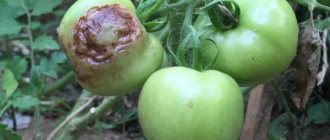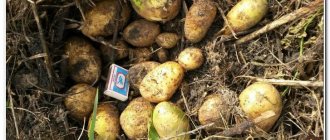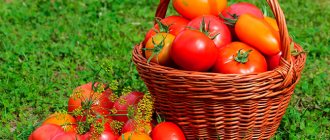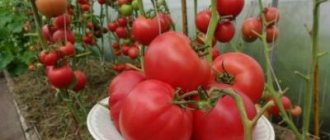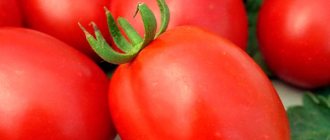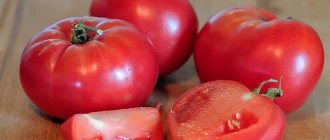Vegetable growing » Tomatoes
0
1874
Article rating
Kira Stoletova
Tomatoes are considered one of the most popular vegetable crops. To get a high-quality and large harvest of tomatoes, you need to choose the right variety for certain growing conditions and carefully care for the seedlings. What is the yield of tomato from one bush, depending on the species characteristics of the vegetable? Is it possible to increase the indicator in this area without harming the fruits?
Indicators of tomato yield per bush
What determines the yield of tomatoes?
When choosing seeds for planting, buyers always pay attention to the yield of a particular variety. This information is usually indicated on the bag. But is it worth counting on these numbers? It should be noted that the yield of tomatoes is far from constant and depends on many factors, such as:
- Biological characteristics of the variety and its regionalization;
- Soil fertility;
- Optimal growing conditions;
- High-quality seedlings;
- Timely watering;
- Fertilizers and fertilizing;
- Correct formation;
- Disease and pest control.
Without attention to tomatoes, there will be no harvest!
Before choosing a variety, you should not rely on the yield indicated on the seed packet. It’s better to look for reviews from gardeners, and from your region. But it is preferable to plant the variety you like and draw your own conclusions.
How to calculate the future harvest
How likely is it to predict the size of the future harvest? This can only be done approximately. Under other suitable conditions for the season, the potential yield is:
- from one bush for early ripening low-growing determinate varieties this figure ranges from 1-5 kg, and for tall indeterminate varieties it can reach about 5-11 kg or more during industrial greenhouse cultivation.
- The yield of pink and large-fruited tomatoes with intensive cultivation sometimes reaches 8-15 kg per bush.
- per hundred square meters you can get from 100 kg to 1.5 tons.
The yield of ground tomatoes largely depends on the growing region:
- for the Moscow region it can be on average 2-6 kg/1 sq.m;
- on average in Russia 1-3 kg/1 sq.m;
- in the southern regions (Krasnodar Territory) they harvest from 2-10 kg/1 sq.m., and record greenhouse yields reach about 30 kg/1 sq.m.
Rules for choosing a productive variety
To have tomatoes all season long, it is not enough to provide good care for the plantings. The correct choice of variety is very important. But it is necessary to take into account the significant difference between varieties for commercial production and for personal consumption. In the first case, the high yield of tomato, the ability to withstand adverse factors and diseases, keeping quality, transportability, shape and size of the fruit become important.
Some varieties produce a harvest of 10-15 tomatoes, each up to a kilogram.
In home gardens, vegetable growers are more concerned with taste, original color and shape, often to the detriment of other properties. After all, tasty fruits with tender and juicy pulp, as a rule, have low shelf life. They are unstable to mechanical stress and are poorly transportable, which makes them unsuitable for sale.
You also need to know where the plants will be grown. For greenhouses, you will need to select special varieties, for example, indeterminate varieties with unlimited growth - they can be more profitable due to higher yields and prolonged fruiting.
But in open ground they are very labor-intensive - you have to additionally install high stakes and make a garter, which is not always justified due to weather and climatic conditions. That is why it is necessary to initially determine the selection criteria. Breeders offer many different high-yielding varieties and hybrids; let’s look at just a few of them.
A BUCKET OF TOMATOES FROM THE BUSH
In any season, amateur vegetable grower Yuri Nikolaevich Ushakov receives fantastic tomato harvests, even until October, and even with the widespread distribution of late blight. He lives and grows tomatoes on the outskirts of the city of Zhukovsky, Moscow region. So today I have already collected 8-10 kg of fruits from the bush.
Science and life // Illustrations
A greenhouse in which Yu. N. Ushakov has been growing many varieties of tomatoes for many years in a row.
In the hands of little neighbor Yu. Ushakov is a giant tomato of the Pink variety.
Yu. Ushakov with his largest-fruited variety Mashenka. Fruit weight is about 800 g.
Dream variety tomatoes.
A bunch of banana variety tomatoes.
Tomato variety Yubileiny Ushakova.
The harvest is ripe!
‹
›
To be honest, I personally didn’t believe it until I visited his (5.5 acres) plot in the Stroitel gardening partnership, on the outskirts of the town of Zhukovsky near Moscow, Ramensky district, Moscow region. I visited and photographed everything. I will reproduce our conversation that took place in the garden almost verbatim.
— Yuri Nikolaevich, let’s not only talk about your technology for growing heat-loving sissies, but also immediately clarify for readers that you grow tomatoes not in the open air, but under glass
…
— Yes, although I have an old one, it’s still a glass greenhouse, almost 47 m2. This is my “lifesaver”, and there is also a small tomato bed in the open ground (the latter, rather, for comparison, experiments and in case of hot summer). I don’t hide it: in the middle zone, the main condition for success when growing such a heat-loving crop as tomatoes is the construction of a greenhouse.
For those who are too expensive for glass, the simplest one is suitable, with a frame made of wooden slats and plastic arches, which are covered with film or non-woven material in early spring. The difference between the temperatures inside such a greenhouse and outside is minimal: two to three degrees.
Therefore, in spring and autumn, gardeners are forced to heat their greenhouses by any means available to them: some with a diesel stove, and some with an electric stove, heating element, or simply a constantly switched on electric light bulb.
Everyone has the same task: as early as possible, without wasting a single precious spring day, plant tomato seedlings in a greenhouse so that they have time to produce their potential harvest. After all, any, even the most productive varieties of heat-loving crops, as a rule, develop slowly in cool spring and June weather. By the beginning of August, when many hobbyists are just beginning to bear fruit, they are destroyed by cold and late blight. Tomatoes, in order to have time to fully “give up” the harvest, need not one warm month (with nights at least 15-18 degrees), but four or five. That’s why I plant seedlings in my greenhouse in mid-April. And favorable conditions for plants in the greenhouse (I additionally cover the roof with plastic film) remain until October - that’s five and a half months.
It is also important that I try to rationally use every meter of space in the greenhouse: in the free rows, between the tomato bushes, I place pots and other containers in which tomatoes also grow. At the end of May, or even at the beginning of June, when the nights become warm, I plant them in open ground. But these are no longer weak seedlings that will not bloom soon, but fruit-bearing powerful bushes. Moreover, they tolerate transplantation painlessly, since I transplant them carefully, without the slightest injury to the roots.
— What else, besides the greenhouse and early planting dates, determines success?
— Please note: at high (more than 35°C) and low (12-14°C) temperatures in combination with high air humidity, tomato flowers are not pollinated and the ovary falls off. Therefore, during the day in July, it is necessary to either regularly ventilate closed greenhouses and greenhouses, or open them completely. I have provided through ventilation for this purpose (doors on two opposite sides and a window on top). In the spring, as well as in July, August, and even more so in September-October, the greenhouse doors should be tightly closed and all cracks sealed.
— Do fertilizers affect the yield and which ones do you use?
— Without effective fertilizers there will be no good harvest. What should it be formed from?
Each fruit plant “takes out” from the soil a total of one and a half dozen macro- and microelements every season. Therefore, they must be returned there in the fall or spring. But, however, with all the “gluttony,” the root system of tomatoes, especially young plants, is unable to effectively absorb nutrition from the soil, especially on cool nights. And phosphorus should be there in an ideal, accessible organic form for tomatoes and in large quantities, as well as potassium, boron, magnesium... Having tested a lot of mineral, organic and even biological fertilizers in my greenhouse, in most of them, to put it mildly , disappointed.
For the second season I have been using humus from horse manure with vermicompost “Gardener’s Dream”. It contains a lot of phosphorus and potassium in organic form available to plants, which, as I said, is necessary for tomatoes. I use this organic matter at the stage of growing seedlings, adding 2 kg of it to each bucket of soil mixture. The result really exceeds all expectations: by the time of planting in the greenhouse, all the tomatoes, with a stem the size of a thick finger, not only have time to bloom, but also already have ovaries.
In addition, when planting plants in a greenhouse, I again add 100-200 g of vermicompost to each hole. The result is similar: the development of tomatoes is noticeably accelerated. The harvest ripens two to three weeks earlier than usual.
— As far as I understand, you, as an amateur, have been growing tomatoes in one place for many years, although this is contrary to generally accepted recommendations: it leads to the accumulation of pathogens in the soil. Scientists recommend returning tomatoes to their original area only after four to five years and planting them only after predecessors such as cucumbers, cabbage, onions, legumes and green crops
.
“Theoretically this is true, but in practice it is impossible to implement such recommendations in a densely planted small area.
I see for myself: when cultivating tomatoes in one place for many years in a row, every year more and more different infections accumulate in the soil, and above all late blight pathogens. What should I do? Every two years we have to do labor-intensive work: completely replace the top ten-centimeter layer of soil in the greenhouse. And this means forced shoveling of tons of earth.
I recently learned about an alternative soil replacement - the FAS sulfur bomb, which can reliably disinfect the top layer of soil from almost any pathogen. I'll definitely try it out in the very near future.
— Now let’s talk about your famous varieties with supposedly incredible yields
.
— Over the 25 years of my hobby, I have scrupulously tested and tested more than 500 different varieties and hybrids. Most of them were “rejected” due to low yield. The so-called “folk selection” varieties, which, alas, are almost unheard of now, turned out to be many times tastier and more productive.
Of course, not all of these varieties are truly good. In the first ten years of my research, I exchanged seeds and nutritional recipes with hundreds of distrustful and restless “tomato fans” like myself. In the end, I settled on tomatoes of undeniable merit (both in terms of yield and taste), which showed themselves not only in ideal conditions. This is, first of all, the Yubileiny Ushakova variety I bred, and also Mechta, Bananchik, Mashenka. All of them are tall, on average up to one and a half meters, and early in maturity. And during a season without climate disasters, they produce an average of 8-10 kg of tomatoes per bush. The fruits are generally not large: Yubileiny Ushakova - 25 g each (with a chicken yolk), Bananchik - 40-50, Mechta - up to 100 g. Only Mashenka is large-fruited - fruits 600-800 g each. At least 10 clusters are formed on all grown varieties , on which 6-15 fruits ripen. They hang in clusters, like grapes.
Well, now about the most important thing: not only the potential yield of varieties is important, but also that it is realized even in not the most favorable conditions and when dangerous diseases are spreading. Here in the middle zone, the harvest of most varieties is destroyed in addition to the cold by late blight. What can resist it?
Using the example of my large collection of varieties, I undertake to assert: different varieties suffer to varying degrees from this destructive fungal disease. Thus, tomatoes of the Yubileiny Ushakov variety have not turned black for three years now. Of course, it is too early to draw final conclusions and it would be best to draw them together with scientists and variety testing specialists. I invite you to cooperation.
Early varieties of tomatoes for growing
If they want to get very early production, then they choose superdeterminants. Basically they give a small but friendly harvest.
- prodigy . Super determinate, compact bush. It ripens in 90 days, the yield is 11 kg/sq.m and higher. The fruit is smooth, tasty, cube-shaped, medium in size, universally used.
- Junior. Ripening in 85 days, low growing, compact, disease resistant, productive.
- Talalikhin 186. High-yielding, flat-round red fruits, low, compact bush, uniform ripening of the crop.
- Buddy. High-yielding, red fruits, on average about 90 g, up to 60 cm in height.
- Vereya F1. Round and large-fruited, tasty, shelf-stable, resistant to bad weather conditions and diseases, high-yielding.
- Anastasia. Productivity – up to 12 kg/s bush, the fruit is red, tasty, weighing up to 190 g.
- Kostroma F1. Semi-determinant, yield up to 18 kg/sq.m in greenhouses, round fruit, dessert taste, resistant to weather changes and diseases.
- Vitador F1. Determinant, the fruit is dense, round and tasty, easily transported and stored in a cluster, yield up to 25 kg/sq.m in a greenhouse.
The Anastasia variety is unpretentious in care and has consistently high yields.
Cio-chio-san
The only disadvantage of this indeterminate (sometimes growing up to 2 m) tomato is the need for support and shaping of the bush. The rest is a set of advantages! It is resistant to unfavorable conditions and can grow even in Siberia and the Far East. It bears fruit well not only in the greenhouse, but also in open ground. It is not afraid of the main nightshade diseases.
“In the greenhouse, I am always pleased with the Chio-chio-san variety from Gavrish. Maria Dolzhikova.
In terms of ripening time, the tomato belongs to the mid-early category - 100-120 days pass from the appearance of the first shoots to the start of fruiting. It won’t let you down with the harvest either - although the tomatoes are small (about 30-40 g on average), they ripen up to 50 pcs. on the brushes! So the yield from a bush with proper care is 4 kg and can reach a record 6 kg. And the taste of this tomato is excellent! And in the blanks it looks very presentable.
“Chio-chio-san - sweet, very productive, tall, with up to 50 smooth, thin-skinned sweet tomatoes in a bunch! Universal for both food and preservation.” Tatyana Vznuzdaeva. Tula region
Raceme varieties of tomatoes
They are interesting because the tomatoes are collected in long clusters that ripen almost simultaneously, which is convenient for collecting produce. They can be stored for a long time, are unpretentious and resistant to a number of diseases, and are highly productive.
- Intuition F1. Mid-season, even in shape, easy to care for, stable yield of 11-12 kg/per bush.
- Samara F1. Early, tall, fruits are round and smooth, sit firmly on the petiole, resistance to cracking, high yield.
Puzata hut
In terms of the number of votes received, it was not far from Monomakh's Cap. The appearance of these tomatoes fully explains the name. Large (300 g), pear-shaped, ribbed, just like squat gnome houses, these tomatoes ripen early - 105-110 days after planting the seedlings. True, they turn red gradually if there is a lot of heat and sun. They are grown in open ground and under film, where they ripen faster. The fruits are fleshy, taste very sweet and juicy.
The bushes are indeterminate, but even in a greenhouse their height rarely exceeds 170 cm. However, it will not be possible to do without shaping. The stems are thin and need staking, as they can lie down under the weight of the fruit. And the yield of these tomatoes, ripening in clusters of 3-5 pieces, is quite decent - 10-11 kg per bush. They are little susceptible to common cultural diseases, but preventive protective measures have never hurt anyone.
“This year I also want a Puzata hut. Last year a friend had them - just a miracle!” Marina Samoilova.
Unusual colorful varieties
Tomatoes with unusual colors often have high yields, as well as increased sugar and vitamin content. Multi-colored productive tomatoes are presented in the table:
| Name | Fruit color | Characteristic | Yield per bush |
| gold fish | bright yellow | Medium late, sweet and tasty fruits | up to 8 kg |
| De Barao orange | orange | Mid-season, resistance to diseases, low temperature and light | up to 15 kg |
| Black Prince | black-raspberry | Mid-season, sweet, disease resistant | up to 8 kg |
| Marshmallow | white | Mid-ripening pulp is tender, weight up to 450 g | up to 8 kg |
| emerald apple | green | Sweet, large, juicy | up to 10 kg |
Multi-colored varieties, for example, the yellow Wonder of the World tomato, show excellent yields, are very healthy and taste good
Large-fruited varieties of red and pink tomatoes
Large red and pink tomatoes show good results. Popular varieties: Bear's Paw, Miracle of the Earth, Sugar Bison, King of the Garden, some others. Large-fruited tomatoes are presented in the table:
| Name | Characteristic | Productivity per 1 sq.m |
| Giant Novikova | Mid-season, large, sweet, ribbed fruits, disease resistance | up to 15 kg |
| Pink giant | Mid-ripening, pink fruit | up to 12 kg |
| De Barao the Giant | Late, fleshy fruits, excellent taste | up to 15 kg |
| Rosana | Early, pink, does not crack, compact bush | up to 9 kg |
| Krasnobay | Mid-ripening, fruits are tasty, aromatic, smooth | up to 30 kg |
| Puzata hut | Early, large fruits of unusual shape, juicy | up to 10 kg |
The large-fruited Puzata Khata variety has fruits of unusual shape and good taste, yield up to 12 kg/sq.m and higher
Tip #1. To get a greater guarantee and a good harvest, plant at least 2-3 productive varieties proven in your region.
Tomato yield in a greenhouse
If we compare the yield of tomatoes when grown in different conditions, the advantage will be on the side of greenhouses, and the yield there is sometimes several times higher. Why is this happening?
- Productivity in open ground is a rather unpredictable value, since it depends on factors such as weather, diseases, and pests. Another thing is greenhouse conditions, where there are much fewer such accidents, so the yield of products is an order of magnitude greater.
- Greenhouse indeterminate tomato varieties with continuous growth significantly exceed soil varieties in terms of yield, which is especially noticeable as the growing period increases. The main thing is not to lose a single day, starting sowing seeds for seedlings as early as possible, especially in heated greenhouses, then these plants will have time to show their full potential.
- It is no secret that even the most productive varieties of tomatoes in open ground conditions develop poorly in cold weather, so they often begin to bear fruit only in August, and by the beginning of autumn they are already faced with cool nights and such a destructive disease as late blight. These factors do not allow large yields to be obtained, because gardeners even have to remove some of the potential ovaries from the bushes so that the rest have time to ripen.
- In a greenhouse, even an unheated one, the growing period is longer, about 5-7 months, which allows you to leave more ovaries on the bushes, with confidence that they will bear fruit.
Forming a bush to obtain a large harvest of tomatoes
At the beginning of August, plants often begin to hurt, the leaves turn yellow and dry, and the tomato fruits turn black and rot. This is late blight, from which it is almost impossible to escape. Therefore, many summer residents collect the remains of the harvest green and ripen the tomatoes in boxes at home. But if you form the stems correctly, you will speed up the ripening of the fruits and collect more red tomatoes on the vine.
To do this, you need, firstly, to grow early ripening varieties and hybrids of tomatoes. Secondly, form tomatoes into only one stem. At the same time, remove all side shoots in time (if you want two stems, you can leave the shoot that appeared under the first flowering brush).
Stepchildren are side shoots in the axils of the leaves. Their removal is called pinching. You need to pinch them off when these shoots reach 5 cm, leaving a stump of 0.5 cm. Then a new one will not grow in this place.
Tomato Black Galaxy
If the tomatoes are not pinched, many new shoots will form on the bush, and flower clusters will appear on each one. Many gardeners feel sorry for cutting off the shoots; in the hope of a large tomato harvest, they allow the bush to grow in all directions. But the more additional stems and ovaries, the slower the fruits ripen. Yes, and there are much fewer of them, and the tomatoes themselves are smaller.
How to increase tomato yield
To increase the yield of tomatoes, you need to follow simple rules:
- Do not grow tomatoes in one place every year, disinfect or change the soil in the greenhouse.
- Plantings should not be thickened; each bush should be ventilated and well lit, since tomatoes love the sun.
- All shoots and unnecessary foliage are removed in a timely manner; no leaves should remain at a height of 30 cm from the ground.
To increase the yield of tomatoes, leaves and shoots must be removed in a timely manner.
- Tomatoes need to be hilled up to form additional roots and mulched - this will retain moisture and protect the bush from overheating in hot weather. If the soil is not mulched, then it must be loosened after watering or rain.
- In the first period, watering should be rare and plentiful; during fruit growth, it is preferable to water 2 times a week in small doses, but regularly, so that the fruits do not crack.
Answers to pressing questions
Question No. 1. What is the best way to water tomatoes in a greenhouse to improve their yield?
Watering in a greenhouse increases the overall air humidity, which is bad for the plants. Therefore, it is best to make a drip irrigation system for tomatoes. As a last resort, you can install 5-liter plastic containers with a cut bottom for each plant. Bury the neck in the ground at the root and pour water or fertilizer into them.
Question No. 2. How can you reduce air humidity in the root zone in a greenhouse to prevent tomatoes from getting sick?
The greenhouse needs to be ventilated, and the soil around the roots must be mulched with sawdust, straw or hay.
Question No. 3. What will improve fruit set?
Periodically shaking the plants or tapping the flowers, spraying the inflorescences with “Tomaton”, a solution of boric acid (10%), and growth stimulants.
Watering tomatoes with boric acid solution
Question No. 4. For what reason do empty and small fruits without seeds appear on a tomato?
This happens when there is a lack of pollination due to very high or low temperatures, lack of light and high humidity.
Question No. 5. Why do fruits crack?
This occurs from uneven watering, from low temperatures at night and high humidity.
A large harvest of tomatoes: what to do with it after harvesting?
A good harvest is both a great joy and a headache dedicated to the main question: where to identify perishable vegetables?
Today we will share with you the secrets of how to quickly and efficiently process ripe tomatoes grown on the plot.
There are many options and methods for processing tomatoes; each housewife has her own “tricks” and signature dishes from this vegetable. The number of options for blanks is limited only by the owner’s imagination.
What are the most popular methods of processing tomatoes? Tomatoes can be:
- freeze after removing the skin from them,
- process into juice
- prepare canned salads,
- make twists from whole tomatoes,
- dry ripe tomatoes,
- dry them.
The bulk of the fruit is still sent for preservation.
The key to successful conservation is compliance with important rules:
- Cleanliness of raw materials and sterilization of containers.
- Fruits for processing must be fresh, free from rot and mold.
- Quality spices and preservatives should be used.
- Storage of workpieces in special conditions.
- Rejection of damaged twists.
You can find thousands of winter tomato twists on the Internet, and we won’t repeat ourselves. We will list you the tricks
, which will facilitate the process of preparing vegetables.
- Many recipes for preparations involve chopping vegetables. You can use a meat grinder, blender or juicer. But before that, you should get rid of the skin. Make cuts in the skin and pour boiling water over the top of the tomato. Wait for 2-4 seconds and carefully remove the vegetable. After such manipulation, the skin will easily separate.
- The twisted tomato mass, although without skin, contains seeds. In order to get rid of the seeds, you should grind the tomato mass through a sieve. Buy a 2 liter sieve, it fits perfectly in a 12 liter bucket. This is very convenient for processing a bountiful harvest.
- Do not wipe the remaining pulp completely; it will work as tomato paste without seasoning. Roll it into small containers and use it in cooking.
- To prevent the jar from bursting due to the hot temperature of the raw materials, lower a long metal spoon into it.
- A very convenient form of storing tomatoes is in dried form. To dry, take ripe tomatoes of “meaty” varieties, cut them into slices and put them in the oven to dry at a temperature of 100 to 150 degrees for several hours. Cooled tomatoes are poured with vegetable oil, spices are added to taste and stored in the cold.
- Making a simple preparation for borscht is easy: take plastic cups, silicone muffin molds or ice molds and fill them with finely chopped tomatoes, herbs, and garlic.
- When pickling tomatoes, you should sort the vegetables by size.
Preparations from fresh and processed vegetables will help you out in the fall and spring and will allow you to quickly come up with delicious dishes based on them, remember the taste of summer and replenish your body’s supply of vitamins.



